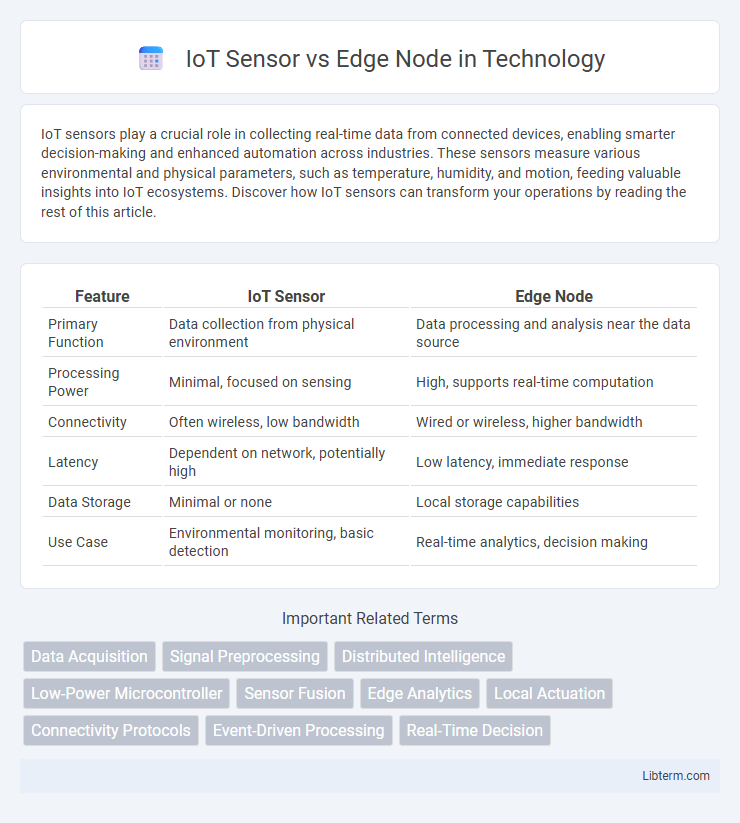IoT sensors play a crucial role in collecting real-time data from connected devices, enabling smarter decision-making and enhanced automation across industries. These sensors measure various environmental and physical parameters, such as temperature, humidity, and motion, feeding valuable insights into IoT ecosystems. Discover how IoT sensors can transform your operations by reading the rest of this article.
Table of Comparison
| Feature | IoT Sensor | Edge Node |
|---|---|---|
| Primary Function | Data collection from physical environment | Data processing and analysis near the data source |
| Processing Power | Minimal, focused on sensing | High, supports real-time computation |
| Connectivity | Often wireless, low bandwidth | Wired or wireless, higher bandwidth |
| Latency | Dependent on network, potentially high | Low latency, immediate response |
| Data Storage | Minimal or none | Local storage capabilities |
| Use Case | Environmental monitoring, basic detection | Real-time analytics, decision making |
Introduction to IoT Sensors and Edge Nodes
IoT sensors are devices that detect and measure physical parameters such as temperature, humidity, or motion, converting this data into digital signals for analysis. Edge nodes function as localized processing units, aggregating and analyzing data near the data source, reducing latency and bandwidth use. Together, IoT sensors and edge nodes enable efficient real-time decision-making in distributed IoT networks.
Defining IoT Sensors: Functions and Features
IoT sensors are devices that detect and measure physical properties such as temperature, humidity, motion, or light, converting these parameters into data signals for processing. These sensors are essential for capturing real-time environmental inputs, enabling applications in smart homes, industrial automation, and environmental monitoring. Key features include low power consumption, wireless communication capabilities, and integration with IoT networks for continuous data transmission.
What Is an Edge Node? Key Components and Capabilities
An edge node is a critical computing device in an IoT network that processes data locally near the data source, reducing latency and bandwidth usage. Key components of an edge node include sensors, processors, connectivity modules, and storage units, enabling real-time data analysis and decision-making at the network edge. Edge nodes enhance IoT system efficiency by performing tasks such as data filtering, aggregation, and local machine learning, which offloads workloads from centralized cloud servers.
Core Differences Between IoT Sensors and Edge Nodes
IoT sensors primarily function as data collectors, detecting environmental changes such as temperature, humidity, or motion and transmitting raw data to centralized systems. Edge nodes, however, are more advanced devices capable of processing, analyzing, and filtering this sensor data locally, reducing latency and bandwidth usage. The core difference lies in the sensor's role as a data source versus the edge node's ability to perform real-time computation and decision-making at the network's periphery.
Data Processing: Sensor-Level vs Edge Node Processing
IoT sensors primarily perform data collection and initial filtering at the sensor-level, enabling real-time monitoring but limited by processing power and energy constraints. Edge nodes handle more complex data processing tasks such as aggregation, analytics, and decision-making closer to the data source, reducing latency and bandwidth usage. This distributed processing framework enhances system efficiency by offloading intensive computations from centralized cloud servers to edge devices.
Communication Protocols: How Sensors and Edge Nodes Connect
IoT sensors often use low-power wireless communication protocols such as Zigbee, Bluetooth Low Energy (BLE), or LoRaWAN to transmit data efficiently to nearby edge nodes. Edge nodes typically employ more robust protocols like MQTT, HTTP, or CoAP to aggregate sensor data and communicate with cloud platforms or centralized servers. The choice of communication protocol depends on factors like power consumption, data rate, range, and network topology to optimize connectivity and performance.
Power Consumption and Efficiency Comparison
IoT sensors typically consume less power as they focus on data collection with minimal processing, making them ideal for battery-powered or energy-harvesting environments. Edge nodes, equipped with greater processing capabilities, require higher power consumption but enhance efficiency by performing data analysis locally, reducing latency and bandwidth usage. Optimizing power consumption in IoT deployments involves balancing sensor simplicity with edge node processing to achieve sustainable and efficient system performance.
Use Cases: When to Deploy Sensors vs Edge Nodes
IoT sensors are ideal for real-time data collection in environments like smart homes, industrial automation, and environmental monitoring where continuous, accurate measurements are critical. Edge nodes excel in scenarios requiring immediate data processing, such as autonomous vehicles or predictive maintenance, where latency reduction and local decision-making enhance system efficiency. Deploy sensors when direct measurement is essential, and deploy edge nodes when local computation and data aggregation optimize network performance and responsiveness.
Security Considerations: Sensors vs Edge Nodes
IoT sensors collect raw data but often lack advanced security features, making them vulnerable to physical tampering and cyber attacks. Edge nodes perform data processing closer to the data source and incorporate enhanced security measures such as encryption, authentication, and intrusion detection systems to protect sensitive information. Securing edge nodes is critical as they serve as intermediate gateways, reducing risks associated with data transmission between sensors and cloud infrastructure.
Choosing the Right Solution for IoT Applications
IoT sensors are primarily responsible for collecting real-time data from the environment, making them essential for precise monitoring in applications such as smart agriculture and industrial automation. Edge nodes, equipped with processing power, enable local data analysis, reducing latency and bandwidth use, which is crucial for time-sensitive applications like autonomous vehicles and predictive maintenance. Selecting between IoT sensors and edge nodes depends on the need for either raw data acquisition or on-site processing, with considerations including network infrastructure, power availability, and application complexity.
IoT Sensor Infographic

 libterm.com
libterm.com